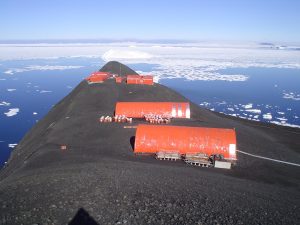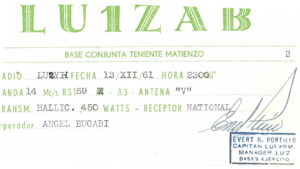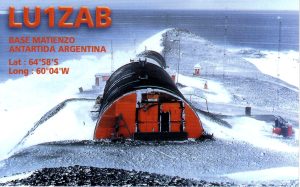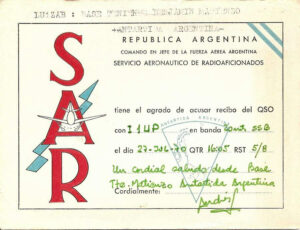 This scientific station, is one of the Argentinean transient Bases on the white continent. Its name is in honor of Benjamín Matienzo, a pioneer of Argentine aviation. In 2009 it became the only Argentine base to have been inhabited exclusively by women.
This scientific station, is one of the Argentinean transient Bases on the white continent. Its name is in honor of Benjamín Matienzo, a pioneer of Argentine aviation. In 2009 it became the only Argentine base to have been inhabited exclusively by women.
Base T.Te Benjamin Matienzo (WAP ARG-Ø1) is located at 64° 58’ South and 60° 08’ West, in the Larsen Nunatak, belonging to the Foca group, on the eastern side of the Peninsula on the Weddell Sea, 186 km southwest of Marambio Base (WAP ARG-21), from where all personnel and cargo transfers are currently made.
The area where the Base is located, was immersed in the Larsen “A” Ice Shelf, completely disintegrated in 1995. Since then, with annual variations, wide sea surfaces with debris and floating icebergs have been exposed.  The facilities of the Base occupy a discontinuous strip of about 300 meters in length, at the eastern and narrower end of the nunatak. It was inaugurated on March 15, 1961, located on the old San Antonio Refuge.
The facilities of the Base occupy a discontinuous strip of about 300 meters in length, at the eastern and narrower end of the nunatak. It was inaugurated on March 15, 1961, located on the old San Antonio Refuge.
It was the first Antarctic detachment created jointly between the Argentinean Army and the Air Force, becoming totally dependent on the latter in 1964, with the new name of Teniente Matienzo Air Base, maintaining an endowment of two single-engine Beaver aircraft, operating from the glacier adjacent to the nunatak.
 Various scientific activities and historical events of international significance were developed at Matienzo. Extensive meteorological and climatological observation programmes were carried out; the glaciological status of the Matienzo-Esperanza route and the coastal channel between Robertson Island to the South was studied; topographic and aerophotographic surveys of the Larsen Ice Shelf were carried out as well.
Various scientific activities and historical events of international significance were developed at Matienzo. Extensive meteorological and climatological observation programmes were carried out; the glaciological status of the Matienzo-Esperanza route and the coastal channel between Robertson Island to the South was studied; topographic and aerophotographic surveys of the Larsen Ice Shelf were carried out as well.
Pic to the Left, shows an old QSL of LU1ZAB dated 1961, the year of the inauguration of Matienzo Base (TNX LU2YH)
In 1965, two Argentine Gamma Centauro rockets, of national manufacture, were launched along with two balloons probes from Matienzo for X-ray measurement. They moved to the place by means of a transport plane piloted by Commander Mario Luis Olezza. That operation, placed Argentina not only among the small number of countries that built rockets in the 1960s for scientific research, but also carried out launches from Antarctica.
In addition, that same year the Matienzo Base constituted the first stop and the fulcrum of Operation South, the first Argentine Transpolar Flight. Four years later, it was also the base of operations for the creation of the Marambio Base.
In 1972, Matienzo was deactivated as a permanent station and since then it was reopened during most of the summer campaigns to perform tasks of flight support, maintenance of facilities, refueling, meteorological observation and support for scientific activity.
In Matienzo, there is an Antarctic Museum, that has been restored in 2018 and exhibits objects, Antarctic accessories and photographs that recall the history of the base.
In the Antarctic Summer Campaign 2008/2009, Matienzo’s staff was made up entirely of women from the Air Force, constituting a historical fact in Antarctica.
 The last reopening of Matienzo was during the 2018 Antarctic Summer Campaign, being operated by a group of ten people, including military and civilians of the Air Force, fulfilling various tasks of maintenance of the facilities and preservation of the environment.
The last reopening of Matienzo was during the 2018 Antarctic Summer Campaign, being operated by a group of ten people, including military and civilians of the Air Force, fulfilling various tasks of maintenance of the facilities and preservation of the environment.
LU1ZAB on air …
After more than 10 years of being inactive, LU1ZAB Matienzo Ham radio Station was activated, which even provided services, as in the old days, for private communications between crew members and their families.
Pic aside and below shows a couple of the last QSLs of LU1ZAB dated 1970 & 1996 (TNX I1UP & I1HYW )
LU1ZAB service, was used as a bridge to make the first radio contacts, later expanded through the phone-patch service, linking the radio equipment with the telephone line, through the Marambio Base.
Thus, the service focuses on the use of radio, in HF bands, historically provided by amateur radio stations could be used directly by those who carry out tasks in Antarctica, as was done so many times in the past.
LU1ZAB amateur radio station’s set up, had several antennas, which allowed testing capabilities and performance, one of the essential functions of this alternative communication service.
